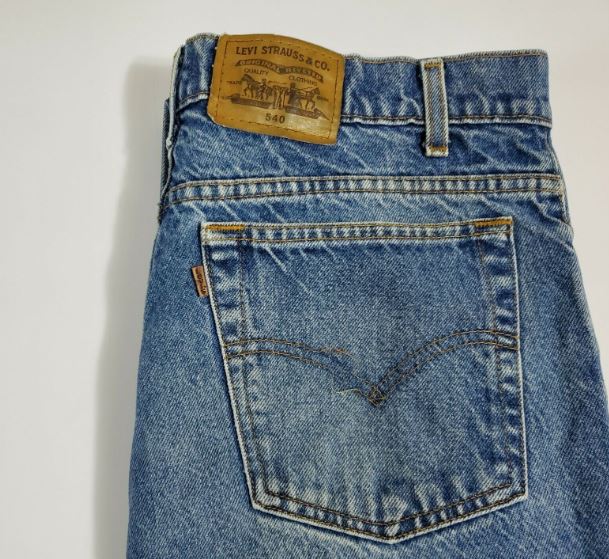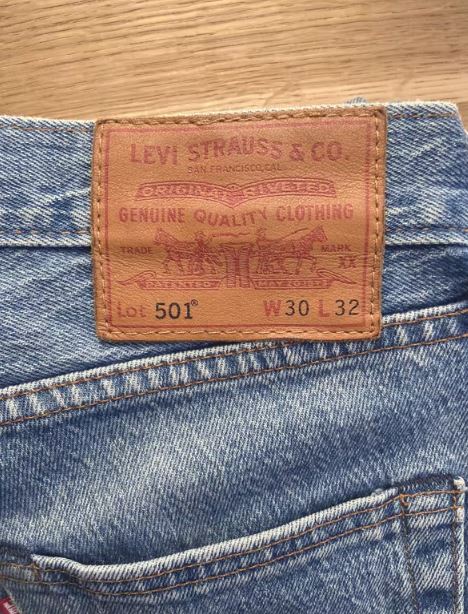Many of us have at least once wondered why jeans always have a leather patch on the back, does this leather piece merely serve as a decorative function?
The piece of leather on the back of the jeans is called a jacron.

The jacron is usually rectangular, sewn at the waist, leaning to one side. Jeans of any brand have this leather piece.
The jacron has been seen as an indispensable part for many years, leading many to wonder why jeans always have a leather patch on the back, does it have any significance other than decorative purposes?
Why do jeans always have a leather patch on the back?
Jacroon helps identify the brand of jeans
The small piece of leather on the back of jeans is a distinctive feature of this garment, albeit small, it plays a quite important role.

First of all, the jacron carries the mission of "identity", helping anyone who sees it to recognize which jeans belong to which brand.
In addition, the jacron is also seen as a decoration for the jeans
The small and cute jacron leather, carefully designed, is also a stylish decoration for the jeans.
Therefore, the brand information on it brings excellent, subtle advertising effects. Wearers often proudly want to show off the high-end brand of the jeans they bought.
History of Jacron
Levi's is said to be the first brand to use jacron.

Before that, the jeans tag was only inside the jeans, but since 1873, Levi's started implementing the idea of cutting small pieces of leather with the brand logo printed on them to paste on the outside.
This was to "mark" the products for customers to recognize genuine items, avoiding purchasing fake Levi's jeans or low-quality jeans.
According to Levi's spokesperson, Jacron will help consumers differentiate genuine products by recognizing them through the logo.

The famous horse-shaped emblem of the brand, and information about the size of the jeans, are something that counterfeit jeans are hard to imitate.
After Levi's, other jeans brands also added jacron to their product designs. In early 2018, American Eagle even opened AE Studio in New York City, where customers could create their own jacron.
And today, around the world, you'll find it very hard to find a pair of genuine jeans without a jacron.

Even though many people still don't understand why jeans always have a leather patch on the back.
Why are jeans blue?
Currently, the color range of jeans is quite diverse, but blue is still the dominant and most popular color.
The world's first jeans were brown.
They were created by Levi Strauss. He collaborated with Latvian Jacob Davis to produce clothes made of canvas raw fabric (cotton thread/cotton woven fabric) and rivets.
This fabric was brown, thick, and extremely durable, suitable for workers doing gold mining.

In 1853, Levis changed its denim material to blue denim fabric.
In fact, workers didn't care about the color, only cared about the durability of the fabric, and the canvas material met that requirement well.
However, the canvas was too thick, making the wearer feel cumbersome, while denim material was both durable, thinner, and softer, giving a comfortable, convenient feeling.
When denim was applied to the production of jeans, canvas material was no longer used for this product.
The blue of denim is the color of natural indigo dye.

If most natural dyes penetrate directly into the fabric fibers when heated, then the dye made from the indigo tree (which is blue) only adheres to the surface of the fabric.
Thus, it needs the catalytic action of a chemical called a mordant.
After each wash, some dye fades away, along with some fabric threads, making the jeans softer and having a unique silver color.
Today, manufacturers use synthetic dyes, the fabric has intelligent fiber structures so the denim fabric fibers today can be dyed many other colors as well.
However, blue is still the most preferred color and when jeans are mentioned, people remember this color.






